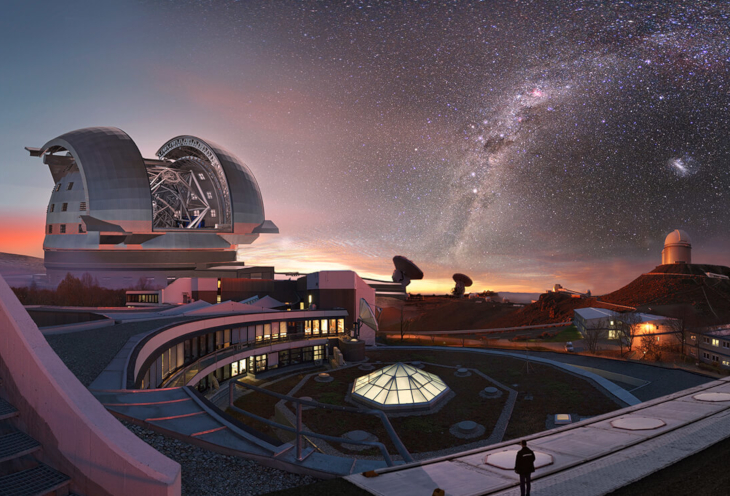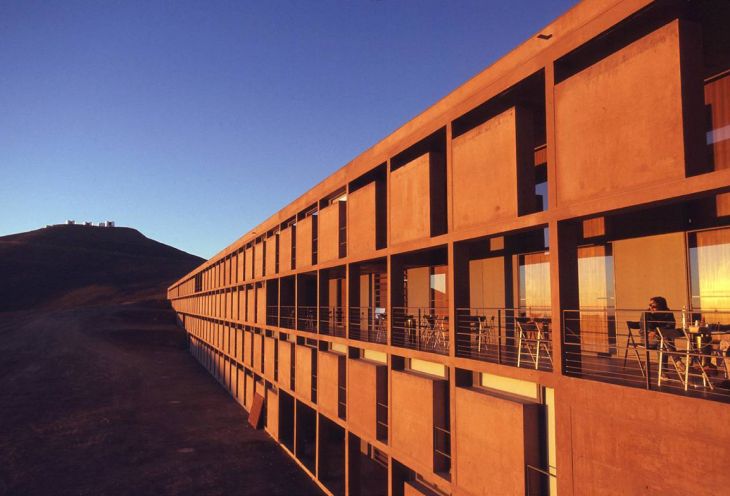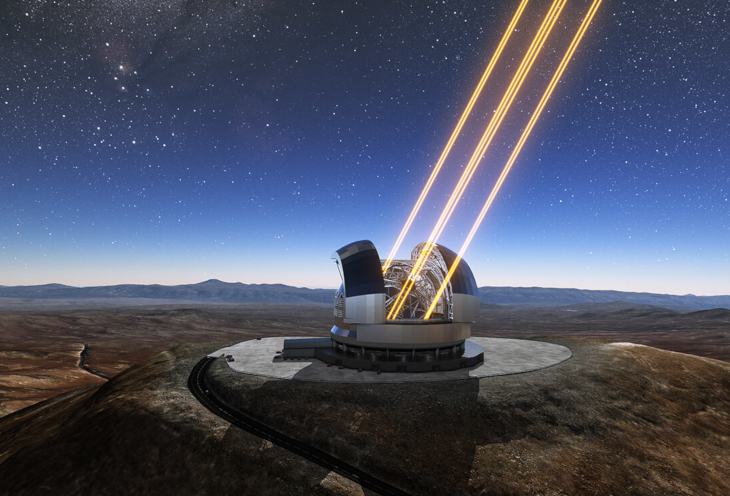It's obvious - they are taking care of good communication. No, it's not an introduction to an inside joke. For a number of Comarch employees, working in a desert is their everyday reality. The Services Sector is leading a project for one of the most advanced observatories in the world. But what is working in the Atacama Desert about? How does one become a systems engineer? Where can you meet the Queen lead guitarist? And, if you celebrate New Year in a desert, do you set off fireworks? For the answers to these questions and more, read our interview with Ryszard Kluza, the head of ICT, and Paweł Ciaranek, a systems engineer.
Interviewer: A desert? Not the most typical work environment. What is the project being carried out in Atacama?
[Ryszard] The European Southern Observatory (ESO), which serves to observe the southern sky, is located in the Atacama Desert, near Paranal. It is one of the most advanced establishments of this kind. It is here that the most significant discoveries concerning outer space in recent years have been made. Comarch has won the contract for information systems maintenance, crucial to ensure the telescopes are operational on a 24 hours-a-day basis. Of course, working on the ground, in the Observatory - in the desert in Paranal, and in our department in Santiago – is part of the larger project. Most of the data and image processing takes place in Garching, near Munich, Germany, where Comarch engineers are also responsible for the uninterrupted and fail-safe operation of IT systems. We ensure that the huge volume of data streaming down from the high-tech telescopes is available for every scientist who studies deep space. Scientists from all over the world come to Paranal. If the telescopes suddenly go off, the loss caused by the interruption could cost hundreds of thousands of dollars.
[Paweł] That's why the even shortest technical break has to be announced and approved several months in advance. There is a waiting list of a year or two, sometimes longer, for astronomers who want to access the Observatory. We have to ensure operational continuity, otherwise a scientist would miss their appointed time and would have to wait several more years for a chance to come to the ESO. In some cases, this could close a window of opportunity permanently - a particular orbital alignment or a passing comet could be a one-time event.

You have mentioned some important discoveries made in Observatory...
[Paweł] The ESO has at its disposal a number of telescope stations. One of them is Paranal, where scientists lead such projects as searching for water on other planets, or tracking black holes. The latest generation of telescopes is dedicated for such projects. In this respect, the topic of “latest discoveries” is inexhaustible. One of the most interesting of them is the “artificial star” phenomena. Earth's atmosphere disrupts images of the sky, so the light collected by lenses experiences various kinds of turbulence and impurities - all of which makes the stars look like they're twinkling, and renders images of space blurry. To be able to handle these disturbances, the most powerful 4LGSF lasers, embedded in UT4 telescopes, are pointed at the sky. At an altitude of 90 km their light creates a “reference star”, and scientists measure its vibrations to adjust discrepancies in images. When it comes to recent discoveries, there are countless examples. Lately, scientists using the VLT telescope discovered titanium oxide in the atmosphere of a planet from beyond the Solar System, the “exoplanet” called WASP-19b. And the significance of this discovery? Enormous! The equipment available in Paranal is able to explore phenomena as distant as the composition of the atmosphere of a planet located 900 light years from the Earth. Moreover, they have recently discovered another piece of the puzzle of the evolution of galaxies and black holes, which used to be a great mystery to us. The scientists discovered the way black holes are being fed by “jellyfish galaxies”. It is an important turning point in studies in this field.
What do the data from these telescopes look like?
[Ryszard] If you think that these telescopes are held by scientists looking at the sky, you are wrong. One telescope alone is the size of a low-rise building.
[Paweł] The images are not direct photos of outer space, they come from deep space. If we tried to examine such a photo on the computer screen, we would get a bunch of pixels difficult to analyze and interpret. Every image must be converted using the appropriate apps, which provide figures. Nevertheless, we can use a VST telescope to capture some beautiful images of galaxies, for example. We handle a load of network connections between the instruments set up in telescopes and the servers storing data, and deal with the configuration of servers and necessary equipment such as laptops and video conference systems. This setup must guarantee the accuracy of streaming data and the infallibility of the continuity of the data record, while also being able to communicate constantly between equipment. The ESO is not only Paranal - there is a unit of professionals in Santiago, and the headquarters is located in Garching, Germany.
Sounds amazing! What are the requirements for a candidate wishing to work on your project?
[Ryszard] You need to be qualified and hold the required certificates. I know from experience that the best people for such projects are those with wanderlust. The Comarch team consists of Poles who are under long-term contracts, and Chileans. There are 12 people altogether, four in Santiago and eight in the Atacama Desert. We work shifts, eight days at Basecamp, then six days off.
[Paweł] Our team is divided into three sections. The systems engineers are responsible for servers and equipment set up with Linux and Unix systems. We have network engineers responsible for the maintenance of configuration and the installation of new connections. Systems engineers maintain Windows servers on service desks and help Windows and Mac OS users. A degree in physics or IT is a good background for this kind of job. I began as a network engineer, holding the ITIL (Information Technology Infrastructure Library) certificate required to be able to understand the service maintenance rules in accordance with international standards and business principles. Another valuable certificate is CCNP (Cisco Certified Network Professional), helpful when it comes to understanding and managing a complex network involving all layers of the ISO/OSI model. Today, I work as a Windows systems engineer – so both ITIL and MCP (Microsoft Certified Professional) are required for this role. The MCP certificate is the basic requirement for professionals using Microsoft technologies, and proves that the holder has crucial knowledge about Windows Server 2012 system installation and configuration. It is currently the most common system for Windows servers used in Paranal. A Linux/Unix systems engineer, on the other hand, should begin by becoming a Red Hat Certified System Administrator (RHCSA). This is not only about a university degree – the most important thing is to use all this knowledge in practice.
What is most challenging about this kind of job?
[Paweł] During the week in a desert, you have to really focus on your work, because the responsibility is great. The service is 24/7, and we are available on the phone and radio all the time. This is the greatest challenge. The job requires you to broaden your skills and learn new things constantly, and to obtain the certificates to back up your knowledge. We cannot fall behind, as equipment and devices change rapidly, and we must be up to date with technologies used in the ESO. There are two things that bring enormous job satisfaction: being surrounded by world-class astronomy specialists, and access to state-of-the-art technologies.
Are there any restrictions regarding physical condition for someone wishing to work in a desert?
[Paweł] Good health is important. For half a year you live at a height of 2 200 meters above sea level, and you have to get to the telescopes located at 2 600 meters several times a day. It may cause shortness of breath, and low pressure can make you dizzy. You should also be stress-resistant, as the projects are challenging. You need courage to decide to move to an unfamiliar continent. But in spite of the fact that it is a desert and the great responsibility that comes with the job, the views in this kind of place are stunning. The morning walk to the office makes you feel better, when you see the clear sky almost every day, and you get a regular dose of sun. It is a truly great place.

How do you spend your leisure time?
[Ryszard] It is a job for people who like to travel around the world. Fun fact: the guys fly a plane to get to work. It is more than 1 000 km from Santiago, where they live, to Paranal. When I was recruiting for the project, I was quite surprised when a guy came to me the day after the job advertisement was published and said: “I want to go to this desert”. At first, I thought: “Did something happen?” But he said no, he just wanted to see a different continent. He made his decision in 24 hours. Working in Chile is the adventure of a life time. In your leisure time, and there's plenty of it, as employees have as long as six days off after a shift in the desert, you can explore the Amazon rainforest, fly to Bolivia, and see Patagonia, the southern part of Chile. Nature there remains untouched.
[Paweł] Our colleagues travel to various places in South America every week, but you can explore Santiago and its neighborhood too. In this city of seven million people there are a surprisingly number of parks where citizens relax at barbecues. There are also a lot of historical monuments and museums to visit. You can go trekking through the city attractions such as San Cristobal mountain, or, for those more demanding, in the Cordillera mountain chain, close to Santiago. It is worth visiting the coast for one or several days, even by public transport, to see beautiful, colorful tourist resorts. You can also go to the Cajon del Maipo canyon, where you can forget city life and see beautiful waterfalls and most scenic views.
Do you also go trekking in the desert when you are in Paranal Basecamp?
[Paweł] You can go for a walk, but some rambles may be dangerous. In the desert, the distances appear to be shorter than they actually are. When you leave Basecamp, you should report to the appropriate service members, and take a radio, flashlight and water supply with you. Everything looks very similar here - it is a rocky desert. In the night, all the lights are turned off to avoid the luminance effect. Lights would interfere with observations, so every illuminated part of the facility has the curtains closely drawn. Near the Observatory, you can only move using designated routes, i.e. “Star Track”, by which it takes 1.5 hours to get from Basecamp, where the offices are located, to the telescopes, on foot. If you get tired, you can go to the main road and hitchhike – it takes about five minutes by car.
[Ryszard] It is suggested to use designated routes. You have to be careful not to lose sight of the Observatory. There was this one time, when a young man went trekking in mountains by himself. He walked down to the valley, did a 180-degree turn and started going back. He wasn't able to find the path he had used to come from the Observatory. The search for him 12 hours. There is no network here - this is the driest desert in the world. This boy was scared witless.
Paweł, what surprised you most when you first came into contact with the desert?
[Paweł] A desert connotes Sahara sand - and the landscape here is totally different. At first, I was astonished by this rocky and tough environment. Neither did the colors reflect what I had imagined. In addition, when you reach the altitude of the telescopes, you find out that the ocean is only 14 km away and you can see this marvelous combination of desert, various kinds of rocks, mountains and ocean, and above all this, the clouds are gathering - a rare view in a desert.
How is living in the Observatory?
[Paweł] The Observatory employees live in Basecamp, an estate of well-equipped portable buildings. Each building has separate rooms, each with bathroom, and there is a dining hall in the hotel. Altogether there are around 200 to 250 people living here, but the premises are growing, as work is in progress on the Armazones, the new generation telescopes, and the biggest ELT (Extremely Large Telescope). There is a gym and sports hall in the Basecamp grounds. You can attend yoga classes. We have a swimming pool, sauna, space for pinball machines, pool table, foosball table, ping-pong table, and PlayStation. There is TV and library with books in several languages, on a variety of topics – not only technical subjects. We have an “Instrumentum”, with many different musical instruments available, such as various guitars, drums, a pipe organ, and music equipment given to the Observatory as a gift from its occupants. If you want to learn how to play a particular instrument, you can arrange lessons. You can observe space and take pictures of a starry sky, as there is a small UT5 telescope available. Fun fact: the hotel, called “Residencia”, may be familiar to fans of the James Bond movies – as it is exactly where “Quantum of Solace” scenes were shot. What's more, Paranal attracts interesting people. I had a chance to meet Bryan May from Queen - he is a Doctor of Philosophy in Astronomy and a huge fan of this place. Steven John Wilson, music producer and vocalist, came here to take pictures for his new album “To the Bone”.

Is here a pub?
[Paweł] No, but there is a small store where you can buy all necessary goods, such as a razor. It is open for an hour every evening, but visiting it is a last resort. All stimulants are prohibited on the premises. Here, everyone works 24/7/365, so employees must always be on standby. On special occasions such as Christmas and New Year's Eve a glass of wine is served during dinner. And that's all.
Have you spent Christmas in the Observatory?
[Paweł] I did spend New Year's Eve in the ESO. You can get to the Observatory territory in two ways: as a tourist, you can register on the ESO website and take part in a guided tour. The second option is dedicated to employees - with the approval of a supervisor hotel administration we can host a guest from outside for a few days. Last year I invited my fiancée and we spent New Year's Eve together, observing stars. It was fantastic.
Were there fireworks?
[Paweł] No. I can assure you, the Milky Way is much more absorbing. Along with the lasers, the ones accompanying the “artificial star”.

Interviewer: Maja Gęgotek
Source of photos: ESO.